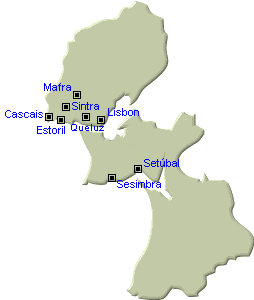|
 Cascais Cascais
 Estoril Estoril
 Lisbon Lisbon
 Mafra Mafra
 Queluz Queluz
 Sesimbra Sesimbra
 Setúbal Setúbal
 Sintra Sintra
 Alentejo Alentejo
 Algarve Algarve
 Azores Azores
 Costa Prata Costa Prata
 Costa Verde Costa Verde
 Madeira Madeira
 Transmontana Transmontana
 Accommodation Accommodation
 Commerce Commerce
 Entertainment Entertainment
 Property Property
 Sports Sports
 Vehicle Hire Vehicle Hire
 Portugal Home Page
Portugal Home Page
|
|
 |
| |
|
 Distances between each Tourist Town in Kms. Distances between each Tourist Town in Kms.
Distances in Kms.
 Lisbon Coast Accommodation Lisbon Coast Accommodation
Lisbon Coast Guest & Manor Houses
Lisbon Coast Holiday Apartments
Lisbon Coast Holiday Rentals
Lisbon Coast Holiday Resorts
Lisbon Coast Hotels
Lisbon Coast Hotels & Spa
Lisbon Coast Inns
Lisbon Coast Pousadas
 Lisbon Coast Golf Courses Lisbon Coast Golf Courses
Lisbon Golf
Lisbon Green Fees
Aroeira I Golf Course
Aroeira II Golf Course
Belas Clube Campo Golf Course
Lisbon Sports Club Golf Course
Melia Capuchos Golf Golf Course
Oitavos Dunes Golf Course
Quinta da Marinha Golf Course
Estoril Golf Course
Ribagolfe I Golf Course
Ribagolfe II Golf Course
Santo Estevao Golf Course
Quinta do Peru Golf Course
Montado Golf Course
Beloura
Penha Longa Atlantico
Penha Longa Mosteiro
Troia
 Lisbon Coast Photos Lisbon Coast Photos
View over Lisbon
· Torre de Belém
· Ajuda Palace
· Rossio Building
· Jardim Tropical
 Introduction to Lisbon Coast
Introduction to Lisbon Coast
This central and most important area is known in the
Portuguese language as "Costa de Lisboa"
and the geographical area was originally created by
the Portuguese Tourist Authority. It extends along
the coastline, starting north of Lisbon
at the beach town of Ericeira and then extends
inland to the east to the town of Abrantes. It
then heads south following the bank of the River Tagus
(Rio Tejo) down to the town of Vila Franca
de Xira. Moving to the southern bank of the river
it cuts across country, southwards, in the direction
of Vendas Novas. Continuing further southwards it
takes in Alcácer do Sal and Grândola
before going west and joining up with the coast on the
sandy beaches of Porto Covo.
There are many towns within this area apart from the
City of Lisbon. From
the visitors point of view the main ones are
Cascais,
Estoril, Mafra, Sesimbra,
Setúbal and Sintra.
The one exception is Queluz
which is only a urban suburb to Lisbon,
but it is very worth while visiting for its charming
Royal Palace which is a much smaller version of that
to be found at Fontainebleau near to Paris in France.
The natural wide water expanse and port created by
the Estuary to the River Tagus also provides good
protected beach locations for holiday makers and their
families. The two towns with these sandy beaches are
at the mouth of estuary and named Cascais
and Estoril, with
swimming conditions that are generally calm with the
sea water almost free from pollution.
Around the corner to the west of Cascais
and facing the Atlantic Ocean are two other beaches,
Guincho and Costa da Caparica. The
former enjoys world-wide fame for its high rollers
and attracts the windsurfers from around the world -
but this beach is not safe for families. The later
of the two beaches is quite the opposite in nature
and much appreciated by people from the
Lisbon area.
Directly to the south below Lisbon
are the two towns of Sesimbra
and Setúbal. The
former was once a small intimate fishing village
before it was discovered by tourism, and the later,
the second biggest port in Portugal and also an
attraction for tourists due to the natural sheltered
cove and blue shallow sea of Pointinho da Arrábida,
and across the Estuary to Troia with lovely
sandy beaches. The town of Setúbal
is connected by two motorways to Lisbon
and acts as a dormitory town and at the same time also
supporting an active fishing industry. Just to the north
of town is Palmela with its restored castle walls
perched high on its hill hiding within an attractive
"Pousada".
In the restoration the past has been carefully respected
and it is a charming place to stay with its magnificent
views across the countryside.
Wine, fruit and horticultural products are in abundance
as the region has many flat areas which contain good
mineral qualities and irrigation . The region is so
rich in its subsoil and it has never been fully
developed. Other main products besides light industrial
items being many marble, granite and schist.
Within the area of "Lisbon Coast" lives more
than 40% of the country’s population and within
Lisbon and the Rio
Tagus valley the density is above double that of
the national average. The core of this area can also
be divided into four sub-regions. The city of
Lisbon itself
on the northern bank of Rio Tejo, the area
directly to the south of the Rio Tejo, the west
coast and the lower Tejo basin. Manufacturing
industry is mainly concentrated on metallurgy, general
engineering, foodstuffs, beverages, tobacco, chemicals
and paper. Nearly 50% of the national catch of fish is
still made from this part of the coast.
Topographically the countryside varies considerably,
from the open rolling plains to the mountain ranges
of the Serra da Arrábida and the Serra de
Sintra, the first to the south of Lisbon,
and the latter being directly to the west between the
coast and the city of Lisbon.
Within the region there are two ecologically protected
areas and are both near to Lisbon.
These are named Reserva Natural do Estuário do Tejo
and Reserva Natural do Estuário do Sado, and
are considered restricted zones against urban development
and nature protected. (Visit - Portugal History)
|





|
|


